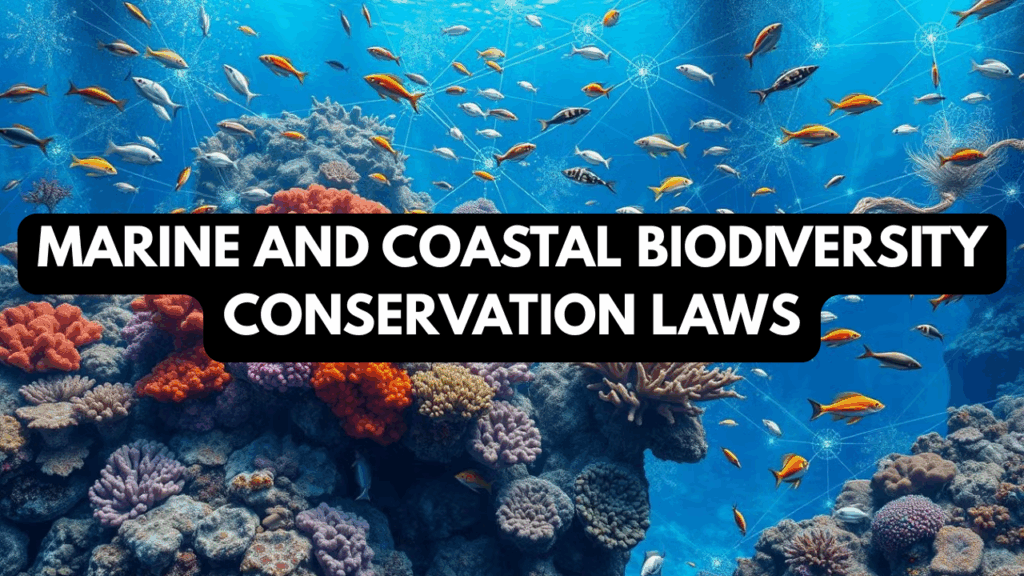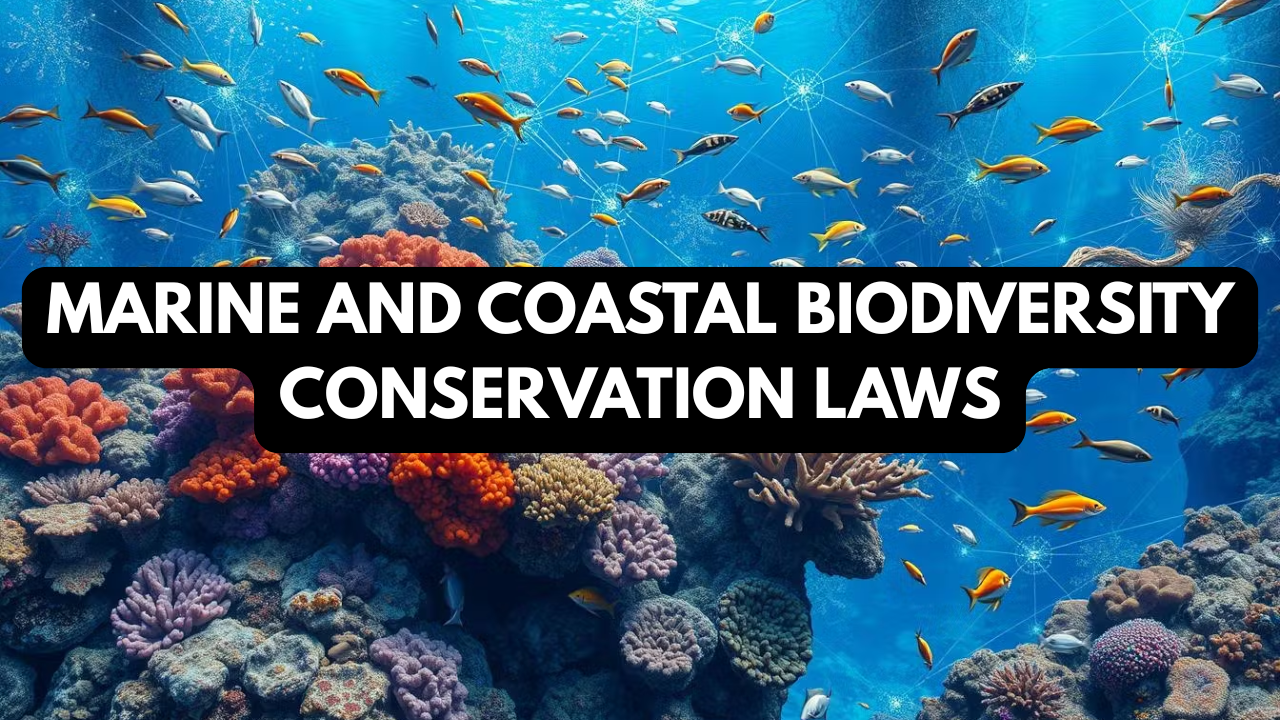
India is blessed with a coastline stretching over 7,500 kilometers, housing diverse ecosystems such as mangroves, coral reefs, lagoons, estuaries, and seagrass beds. These habitats support countless marine species and sustain the livelihoods of millions of coastal communities. However, rapid urbanization, industrialization, overfishing, and climate change have placed immense stress on marine and coastal biodiversity. To address these challenges, India has developed a comprehensive legal and policy framework to conserve and regulate the sustainable use of coastal and marine ecosystems.
Importance of Marine and Coastal Biodiversity
- Ecological Value – Coastal ecosystems act as breeding grounds for fish, protect shorelines from erosion, and regulate carbon cycles.
- Economic Significance – Fisheries, aquaculture, shipping, and tourism depend on healthy marine ecosystems.
- Livelihoods – Millions of fisherfolk and coastal communities directly rely on marine resources.
- Climate Protection – Mangroves and coral reefs act as natural buffers against cyclones and sea-level rise.
Key Legal Framework for Marine and Coastal Conservation in India
1. Wildlife Protection Act, 1972
- Provides protection to marine species such as turtles, dolphins, and corals under Schedules I & II.
- Establishes Marine Protected Areas (MPAs) like Gulf of Mannar and Sundarbans.
2. Environmental Protection Act, 1986
- A comprehensive law empowering the government to regulate activities affecting the coastal environment.
- Basis for Coastal Regulation Zone (CRZ) Notifications which control industrial activities near the coast.
3. Coastal Regulation Zone (CRZ) Rules, 1991 & 2011
- Classifies coastal areas into zones (CRZ I–IV).
- Restricts construction, sand mining, and industrial projects in ecologically sensitive zones.
4. Biological Diversity Act, 2002
- Promotes conservation of marine genetic resources.
- Empowers National Biodiversity Authority (NBA) to regulate access to marine bio-resources.
5. Indian Fisheries Act, 1897 & Marine Fishing Regulation Acts (State Laws)
- Regulate fishing practices, prohibit destructive fishing methods like dynamite or poison, and impose seasonal bans.
6. Indian Ports Act, 1908 and Merchant Shipping Act, 1958
- Prevent marine pollution caused by oil spills, ballast discharge, and shipping operations.
7. Forest Conservation Act, 1980
- Provides indirect protection by regulating mangrove clearance and coastal afforestation.
International Commitments
India is a signatory to several conventions influencing domestic marine conservation laws:
- UNCLOS (United Nations Convention on the Law of the Sea) – Defines India’s rights in its Exclusive Economic Zone (EEZ).
- Convention on Biological Diversity (CBD) – Obligates India to protect marine ecosystems.
- CITES – Regulates trade in endangered marine species like seahorses and corals.
- RAMSAR Convention – Protects coastal wetlands of international importance.
Challenges in Marine and Coastal Biodiversity Conservation
- Overfishing and Bycatch – Unsustainable fishing depletes marine stocks.
- Pollution – Industrial waste, plastic debris, and oil spills degrade habitats.
- Climate Change – Rising sea levels, coral bleaching, and cyclones threaten coastal ecosystems.
- Weak Enforcement – Laws exist but are poorly implemented at the local level.
- Conflicts with Development – Port expansion, coastal highways, and tourism projects often clash with conservation efforts.
- Community Exclusion – Local fisherfolk sometimes feel alienated from conservation decisions.
Case Studies
- Gulf of Mannar Biosphere Reserve (Tamil Nadu): Protects over 4,000 species, including endangered dugongs and corals.
- Chilika Lake (Odisha): Declared a Ramsar site, supports rich biodiversity and local livelihoods.
- Sundarbans (West Bengal): World’s largest mangrove forest, critical for biodiversity and cyclone protection.
Achievements and Gaps
| Aspect | Achievements | Gaps/Challenges |
|---|---|---|
| Legal Framework | Multiple acts protect species and habitats | Overlaps and lack of coordination |
| Protected Areas | 25+ Marine Protected Areas established | Limited coverage, often paper declarations |
| Community Involvement | Eco-tourism and fishing bans involve locals | Alienation of fisherfolk from decision-making |
| International Cooperation | Compliance with UNCLOS, CBD, Ramsar | Enforcement at EEZ level remains weak |
| CRZ Rules | Regulates construction and industry | Dilutions in CRZ norms weaken protection |
| Scientific Monitoring | Marine research institutions established | Limited data and inadequate funding |
Strategies for the Future
- Strengthen Marine Protected Areas: Expand and enforce MPAs with active community participation.
- Sustainable Fishing Practices: Encourage eco-labels, seasonal bans, and gear restrictions.
- Integrating Coastal Communities: Fisherfolk should be key stakeholders in conservation programs.
- Blue Economy Framework: Balance conservation with sustainable economic use of marine resources.
- Climate Resilience: Restore mangroves and corals to act as natural buffers.
- Technology Use: Satellite monitoring, AI-based fisheries tracking, and pollution surveillance.
Overview Table
| Law/Policy | Focus Area | Impact |
|---|---|---|
| Wildlife Protection Act, 1972 | Protection of marine species | Established MPAs, species conservation |
| Environmental Protection Act, 1986 | Pollution control, CRZ rules | Regulates coastal industries, habitat safety |
| CRZ Rules, 1991 & 2011 | Coastal zoning & restrictions | Limits destructive activities in CRZ I areas |
| Biological Diversity Act, 2002 | Marine genetic resources | Ensures fair use and conservation |
| Fisheries Acts | Fishing regulations | Bans destructive fishing, seasonal restrictions |
| International Conventions | UNCLOS, CBD, CITES, Ramsar | Strengthens India’s global commitments |
Conclusion
India’s marine and coastal biodiversity is not only an ecological treasure but also a foundation for livelihoods, climate security, and national development. While laws and international commitments exist, gaps in enforcement, overlapping jurisdictions, and climate threats continue to challenge conservation efforts. The way forward lies in strengthening legal enforcement, involving communities, promoting sustainable development, and restoring ecosystems. Only through integrated efforts can India safeguard its blue wealth for future generations.
FAQs
Q1. Which law provides protection to marine species in India?
The Wildlife Protection Act, 1972 protects marine animals like turtles, dolphins, and corals.
Q2. What are CRZ rules?
Coastal Regulation Zone (CRZ) rules regulate construction and industrial activities in ecologically sensitive coastal areas.
Q3. Why is community participation important in marine conservation?
Involving fisherfolk and coastal communities ensures sustainable use of resources and prevents conflicts.

